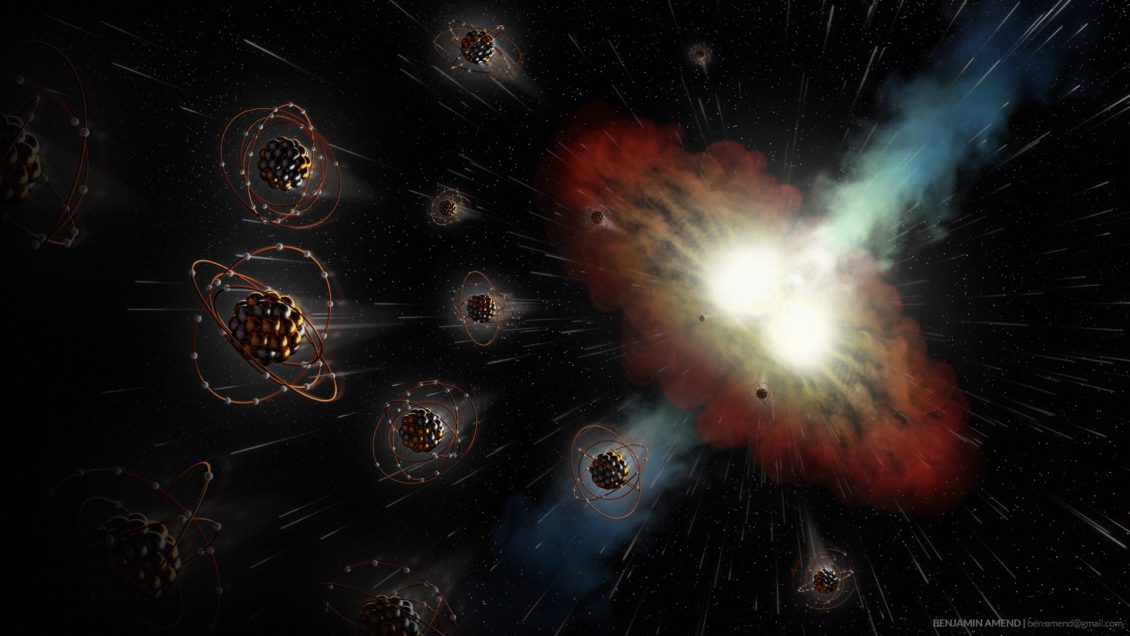
Discovery could influence future missions into space
Violent explosions that ripped through our galaxy before the sun was born are thought to be responsible for the wealth of elements — particularly heavy metals such as gold and platinum — that are part of the makeup of our planet. Three Clemson University scientists are looking into exactly how these elements were produced and distributed throughout the Milky Way.
The trio — Benjamin Amend, Jonathan Zrake and Dieter H. Hartmann — have authored a paper titled “R-process Rain from Binary Neutron Star Mergers in the Galactic Halo,” which was recently published in The Astrophysical Journal.
The rapid neutron-capture process, or “r-process” referred to in the title, creates many of the heavy elements.

“Here on Earth we have a lot of heavy chemical elements like gold and platinum. The question is where did they come from. How were they produced?” explained Amend, lead author and a fourth-year Ph.D. student in the Department of Physics and Astronomy. “Where in the galaxy were they produced, and how were they transported here?”
Scientists know that when stars explode and die, they produce heavy metals. But not all stars’ deaths are equal, and typical supernova explosions do not synthesize significant quantities of r-process elements. However, a different type of explosion, produced following the collision of two neutron stars (ultra-dense remains of massive dead stars), might have the right conditions.
“Sometimes, when both stars in a binary system die and explode, they remain gravitationally bound, forming a neutron star binary system,” Amend said. “The neutron stars are very compact cores of neutron-rich material. Many of these paired neutron stars will orbit around their center of mass and eventually spiral inward and merge with each other.”
Resulting explosion
Scientists describe the resulting explosion as a kilonova.
“A kilonova is the event associated with these binary neutron star mergers,” Amend said. “It’s an extremely energetic explosion that produces a lot of these heavy chemical elements.”
Amend noted that many, or even most kilonovae, are thought to take place in the outskirts of galaxies, in regions referred to as the halo. Supernovae, on the other hand, generally go off in regions where stars are forming, such as in the flat, disk-like region of the Milky Way.

Amend and his collaborators are trying to understand how the newly minted material could make its way from kilonova sites in the Milky Way’s gaseous halo into the disk where it could be recycled into stars and planets. Did it float slowly through the galaxy, or did it have help?
“The origin of the elements is a long-standing theme in astrophysics,” Hartmann, a professor in the Department of Physics and Astronomy, explained.
Thinking about the dispersed elements, Hartmann contacted Zrake, an assistant professor at Clemson and a computational astrophysicist. “He had consulted me because he suspected that the result could depend on the dynamics of interstellar gas motions, and that’s where my expertise is,” Zrake recalled. “I do computer simulations of hydrodynamic flows.”
Moving through the galaxy
Zrake shared his computer code with Amend, who used it to study the phenomenon of flows moving through the galaxy, which the pair compared to putting a couple of drops of ink into a cup of water to see how the ink disperses.
“Ben looked at what happened, and we found that nobody had the right mental picture of what could happen after the neutron star merger,” Zrake said. “No one had really discussed the qualitative aspects of what would happen to the metals that it was exploding into the halo environment.”
Zrake said the initial paper doesn’t include the computer simulations, which he said will be explored in a subsequent paper. “We decided the first paper would outline the qualitative aspect of the heavy element distribution.”

According to Amend, one of the paper’s main conclusions is that the material from the explosions of binary neutron stars can reach the disk through two methods. It can get to the disk through either very slow-acting turbulent diffusion — the mixing that takes place in the halo and disk environments — or through large-scale flows of gases and other materials.
“So together we worked out the mathematics, which we refer to as a ‘toy model,’” Zrake said. “It’s a toy model because it captures the basic qualitative aspects in a way that we can study with pencil and paper. It’s a thing that can be tested against more detailed calculations than could be done with the computer code.”
Hartmann said he expects the paper will contribute to understanding how heavy metals are spread through the galaxy and could also influence future missions into space.“Ben’s Ph.D. project will advance several aspects of the enrichment history of stars and gas in the Milky Way,” Hartmann said. “The impact of this investigation on the field will be through an advance in GCE [galactic chemical evolution] modeling and could drive the development of new observing strategies or NASA/European Space Agency missions.”
The College of Science pursues excellence in scientific discovery, learning, and engagement that is both locally relevant and globally impactful. The life, physical and mathematical sciences converge to tackle some of tomorrow’s scientific challenges, and our faculty are preparing the next generation of leading scientists. The College of Science offers high-impact transformational experiences such as research, internships and study abroad to help prepare our graduates for top industries, graduate programs and health professions. clemson.edu/science
Get in touch and we will connect you with the author or another expert.
Or email us at news@clemson.edu
